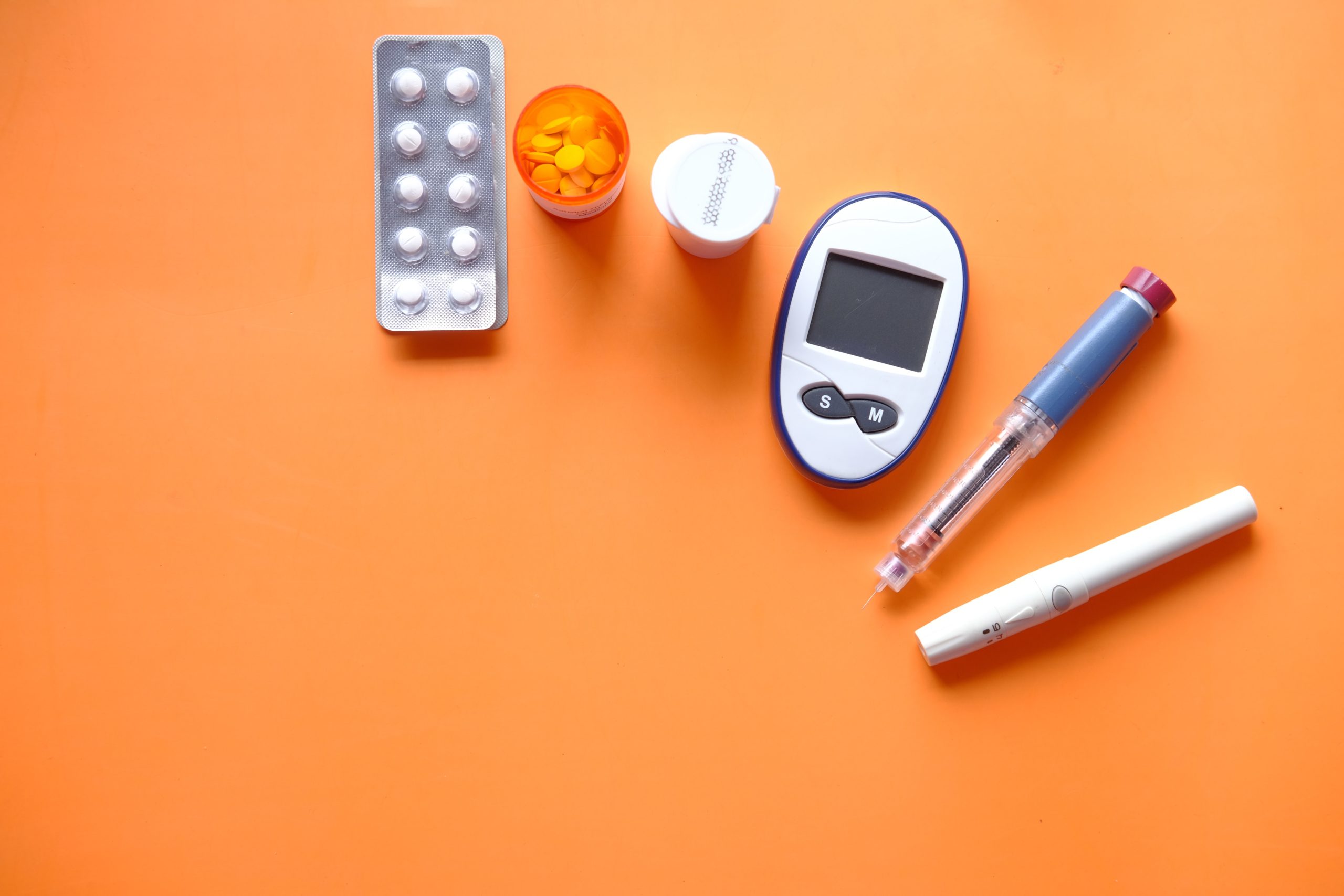Diabetes is a medical term for elevated blood sugar or blood glucose. Your body converts most of the food you eat into sugar as it then enters your bloodstream. A hormone called insulin lets the sugar in your bloodstream into the cells. The sugar provides energy for your cell to function.
That said, you develop diabetes when your body does not produce enough insulin, or if your cells are resistant to insulin. When this happens, high glucose levels build up in your blood, leading to hyperglycemia.
If not managed, diabetes may lead to complications like impaired vision, heart disease, diabetes feet problems and more. The United States Centers for Disease Control and Prevention (CDC) says diabetes is the N0. 1 cause of kidney failure, lower-limb amputations and adult blindness.
Key Facts About Diabetes
- More than 37 million U.S. adults have diabetes and about 23.0% do not know they have it.
- Diabetes is the seventh leading cause of death in the U.S.
- Men are more likely to develop type 2 diabetes. We will explain the differences between type 2 and type 1 diabetes later in this article.
- The risk of developing diabetes increases with age. People aged 45 years or older have increased risk.
Types of Diabetes and ICD-10 Codes
In broader terms, diabetes is a group of disease conditions that describes a build-up of sugar in the bloodstream. However, the types of diabetes differ in some respects.
Essentially, diabetes is classified according to its cause.
Science identifies the three main types of diabetes:
- Type 1 diabetes
- Type 2 diabetes
- Gestational diabetes
ICD stands for International Classification of Diseases, and ICD-10 means Tenth Revision. It is a system that physicians use to label and classify symptoms, diagnoses, and procedures for insurance claim processing.
Gestational Diabetes Snacks
Snacking is an important aspect of managing gestational diabetes, as it can help maintain stable blood sugar levels and prevent hunger and cravings. However, it is important to choose healthy snacks that are low in carbohydrates and high in fiber and protein. Good snack options for gestational diabetes include fresh fruits, vegetables, nuts, seeds, and low-fat dairy products such as Greek yogurt or cottage cheese. It is also important to watch portion sizes and to space out snacks throughout the day, rather than eating large amounts at once. Consultation with a registered dietitian can help develop a personalized gestational diabetes meal plan that includes healthy snack options.
Type 1 Diabetes Causes
The beta cells in your pancreas produce insulin that regulates blood sugar. Type 1 diabetes sets in when your immune system attacks and destroys these beta cells. The damage is irreversible. These are the main causes of type 1 diabetes.
Scientists do not clearly understand what makes the immune system attack beta cells. Genetics and environmental factors are thought to play a big role.
Type 1 diabetes accounts for 5-10% of all diabetic conditions. It’s more common in children, teens and young adults, and this explains why people call it juvenile diabetes.
Type 2 Diabetes Causes
Unlike type 1 diabetes, there’s no lack of insulin in type 2 diabetes. With type 2 diabetes, your cells no longer respond to insulin. This is the main cause of type 2 diabetes.
Your body’s resistance to insulin causes the pancreas to overwork and produce more insulin. Over time, the pancreas won’t be able to produce more insulin to make up for the resistance. Therefore, more sugar stays in your bloodstream.
About 90-95% of the diagnosis accounts for type 2 diabetes. People 45 years or older are more likely to develop type 2 diabetes. Also, being overweight, having a family history of diabetes and sedentary lifestyle are major risk factors.
Gestational Diabetes
Gestational diabetes, or gestational diabetes mellitus (GDM), occurs in pregnant women that never had diabetes. In GDM, the baby is at risk even though the sugar accumulates in the mother’s bloodstream.
Researchers attribute diabetes in pregnancy to the anti-insulin effects of pregnancy hormones.
Every year, about 10% of pregnancies in the U.S. are affected by gestational diabetes, according to the American Diabetes Association (ADA). The onset of gestational diabetes is between 24 to 28 weeks of pregnancy.
If unmanaged, GDM may progress to type 2 diabetes. In fact, the CDC says about 50% of people with gestational diabetes develop type 2 diabetes.
Risk factors for GDM include:
- A family history of diabetes
- Polycystic ovary syndrome (PCOS); more than half of women with PCOS develop type 2 diabetes by age 40
- Preexisting diabetes
- Physical inactivity
- Overweight or obesity
Some people classify prediabetes as a form of diabetes. What’s prediabetes?
Prediabetes is elevated blood sugar levels not high enough to be diagnosed as type 2 diabetes. Like type 2 diabetes, insulin resistance is the cause of prediabetes.
About 96 million U.S. adults have prediabetes and over 80% don’t know they have it.
What are ICD-10 Codes?
ICD refers to the international classification of diseases, and the number 10 denotes the 10th revision. These codes are used to classify and code diagnoses and medical procedures.
These codes help with accurate reimbursement.
ICD-10 codes for major types of diabetes are.
- Type 1 diabetes ICD-10 code is E10. XXX
- Type 2 diabetes ICD-10 code is E11. XXX
- Gestational diabetes ICD-10 code is 024.429
- ICD-10 code for prediabetes is R73.09
The three X provides details such as whether the diabetes is well controlled or not and if there are complications.
For example, E10.1X codes for type 1 diabetes with ketoacidosis, while E10.21 signifies type 1 diabetes with nephropathy.
What are the Symptoms of Diabetes?
The general symptoms of diabetes are:
- Frequent urination at night
- Tiredness: Since your cells no longer receive adequate sugar
- Increased thirst and hunger
- Sores that heal slowly
- Dry skin
- Numbness or tingling hands or feet
- Blurry vision.
Type 1 Diabetes Symptoms
People with type 1 diabetes may experience nausea, vomiting and stomach pains. Other symptoms of type 1 diabetes include weight loss and diabetic ketoacidosis (DKA).
DKA is due to your body’s inability to utilize blood sugar. So the body breaks down the fat into energy, thus releasing ketones into the blood. The presence of ketone in the blood helps in type 1 diabetes diagnosis.
Type 2 Diabetes Symptoms
The symptoms of type 2 diabetes take years to develop, and some people don’t experience any symptoms. In addition to the general symptoms listed earlier, people with type 2 diabetes may have dark patches on the skin. If you’ve any of the risk factors, ensure you consult your doctor.
Cystoid Macular Edema – Common with Diabetes
Cystoid macular edema (CME) is a condition characterized by the accumulation of fluid in the macula, the central part of the retina responsible for sharp, detailed vision. It can cause blurred or distorted vision, as well as central visual loss. CME is commonly associated with conditions such as diabetes, uveitis, and age-related macular degeneration. The condition can be diagnosed through a dilated eye exam or imaging tests such as optical coherence tomography (OCT). Treatment options for CME may include corticosteroid eye drops, injections, or implants, as well as anti-vascular endothelial growth factor (anti-VEGF) medications. The management of underlying conditions such as diabetes can also help reduce the risk of CME.
What are the Tests and Diagnosis for Diabetes?
Doctors measure blood sugar (glucose) to confirm if you have diabetes or not. Experts recommend that people who experience symptoms of diabetes or are at risk should get tested.
Early detection helps prevent complications.
A1C Test: The A1C test, or hemoglobin A1C, measures your average blood sugar over the last two to three months. Sugar attaches to red cell hemoglobin in your bloodstream, so people with higher blood sugar have more hemoglobin coated with sugar.
A healthy A1C level is below 5.7%, while a range of 5.7% to 6.4% indicates prediabetes. At 6.5% or more, the indication is diabetes.
Experts say the higher your A1C, the greater the risk of developing type 2 diabetes.
Random Blood Glucose Test: a Random blood sugar (glucose) test measures your blood sugar at the time of taking the test. Doctors carry out this test when you have symptoms of diabetes.
If your result shows 200 mg/dL (11.1mmol/L) or more, it indicates that you have diabetes.
Fasting Blood Glucose Test: Commonly called FPG test for short, it measures your blood sugar at least eight hours after eating or drinking water. Your healthcare provider may suggest that you fast overnight and take the test in the morning.
FPG test result of 99 mg/dL (5.5mmol/L) or lower is normal, while 100 to 125 mg/dL ( 5.5 to 6.9mmol/L) is the reference range for prediabetes. You will be diagnosed with diabetes at 126 mg/dL (7.0mmol/L) or more.
Oral Glucose Tolerance Test (OGTT): The glucose tolerance test measures how your body tolerates or handles the sugar it gets from food or drink. It’s a diagnostic test for diabetes, prediabetes and gestational diabetes.
The test is in two stages- a 3-hour glucose test. The first stage involves measuring your blood glucose level at least 8 hours after eating or drinking. After this, you take a drink containing about 75 grams of sugar. Your blood sample will be taken 2 hours later to measure the sugar content.
At this period, a blood sugar of 140 mg/dL (7.8mmol/L) is normal, but between 140 mg/dL (7.7mmol/L) and 199 mg/dL (11.1mmol/L), you have prediabetes. 200 mg/dL or higher is a diagnosis of diabetes.
Although most tests don’t confirm the type of diabetes you’ve. Factors that indicate the type of diabetes include:
- Age
- Weight
- Family history
- How fast the symptoms appear.
However, some antibodies inside the blood are markers for type 1 diabetes. So your health care professional may test your blood for these antibodies.
How to Prevent Diabetes?
Prevention, they say, is better than cure. This also holds true for diabetes. Since the disease comes with all sorts of burdens – financial, physical, and mental – it’s necessary to have the right preventive measures at your fingertips.
The mainstay for diabetes prevention and, to a larger extent, its management involves a combination of lifestyle modifications.
1. Watch Your Diet
Studies link certain types of food to diabetes, especially type 2 diabetes. Experts advise you to reduce the quantity of carbs having high sugar. E.g. sweetened beverages, trans fats, rice, pasta, fruit juice, and dried fruit all have high glucose values. It’s better to avoid these foods, especially if you have prediabetes.
Suffice it to say it might be difficult to avoid these foods completely, a safer and healthier choice is to consume carbs that are rich in fiber. Examples are broccoli and whole fruit.
Generally, a type 2 diabetes diet has high nutrients, low fat and calories. The same is true for a type 1 diabetes diet.
Best Foods For Diabetes Prevention and Control
Now that you know what foods are bad for type diabetes, let’s recommend some of the best foods that can help you prevent or manage diabetes.
- Non-starchy vegetables like cucumber, mushrooms and tomato
- Leafy greens
- Nuts and Eggs
- Seeds
- Natural Fats
- Apple Cider Vinegar
- Strawberries
- Cinnamon and Turmeric.
2. Exercise Regularly
Lack of exercise is a risk factor for diabetes. Researchers say some types of physical activities increase insulin sensitivity, thereby letting sugar into your cells. The implication is that your body requires less insulin to regulate blood sugar. In this case, your pancreas doesn’t overwork, thus halting the path to diabetes.
Some beneficial physical activities include brisk walking, bicycling, swimming and mowing the lawn. The CDC recommends getting 20 to 25 minutes of activity every day.
3. Shed Excess Weight
Excess fat complicates diabetes. In particular, fat deposition in the mid-section, also known as truncal obesity, plays the highest role. Therefore, losing some weight is particularly important to lower the risk of type 2 diabetes.
The goal for most weight loss plans is for the obese or overweight person to lose as little as 5 to 7% of body weight.
It is essential to mention that diet is central to your weight loss journey. Lean proteins, healthy fat and non-starchy vegetables are good foods to help you lose the weight you need to.
4. Quit Smoking
Smoking is linked to many health conditions, and diabetes is one. How smoking causes diabetes, especially type 2 diabetes, is not fully known. But researchers believe smoking decreases insulin secretion and increases its resistance.
The risk of developing type 2 diabetes is 30-40% higher in people who smoke cigarettes compared to those who don’t smoke.
This study concludes that smoking cessation (quitting smoking) for ten years or more decreases the risk of type 2 diabetes to the level of someone who never smoked.
Therefore, quitting smoking is a tip for the prevention of diabetes.
Other Tips for Diabetes Prevention Are:
- Eat smaller portions
- Be more active. I.e. reduce sedentary lifestyle.
- Replace sugary beverages with water
- Increase vitamin D intake. Exposure to moderate sunlight, cod liver oil and fatty fish are also good sources of vitamin D.
What are the Treatment Options for Diabetes?
Diabetes has no cure yet. Diabetes treatment involves a combination of lifestyle changes, medication and regular monitoring of blood sugar levels.
Type 1 Diabetes Treatment
Type 1 diabetes is treated with insulin therapy, which replaces the insulin the body cannot produce. We can deliver such insulin through injections or an insulin pump. Continuous glucose monitoring is also used to monitor blood sugar levels and adjust insulin doses accordingly.
Each treatment option has pros and cons, and your healthcare professional should personalize the most appropriate treatment plan to your needs.
Type 2 Diabetes Treatment
Your doctor may prescribe oral medications such as metformin, sulfonylureas and thiazolidinediones to help lower your blood sugar levels. You may also require insulin therapy in some cases.
Additionally, lifestyle modifications such as regular exercise, healthy eating, and weight loss can help to manage blood sugar levels and prevent complications.
Ensure for Diabetics
Ensure is a nutritional supplement designed to provide balanced nutrition to individuals who may have difficulty meeting their nutritional needs through diet alone. For people with diabetes, it can be an effective way to manage blood sugar levels while providing essential nutrients. Ensure for diabetics is formulated to contain a balance of carbohydrates, fats, and proteins that can help manage blood sugar levels. It also contains fiber, which can help regulate digestion and slow the absorption of carbohydrates, reducing the risk of spikes in blood sugar levels. However, it is important to consult a healthcare provider before adding Ensure or any other nutritional supplement to your diet, as individual nutritional needs may vary.
Smoothies for Diabetics
Smoothies can be a healthy and delicious way for individuals with diabetes to meet their nutritional needs. When prepared correctly, smoothies for diabetics can provide a balance of carbohydrates, fats, and proteins while helping to manage blood sugar levels. The key is to use low-glycemic fruits and vegetables, such as berries, leafy greens, and avocados, which are less likely to cause spikes in blood sugar levels. Adding protein-rich ingredients such as Greek yogurt, tofu, or nut butter can also help slow the absorption of carbohydrates, providing sustained energy throughout the day. It is important to consult a healthcare provider or a registered dietitian to develop a smoothie recipe that meets individual nutritional needs.
Protein Shakes for Diabetics
Protein shakes can be a convenient and effective way for individuals with diabetes to meet their nutritional needs and manage blood sugar levels. Protein is an essential nutrient that helps build and repair tissues, and it can also help slow the absorption of carbohydrates, preventing spikes in blood sugar levels. When selecting protein shakes for diabetics, it is important to choose low-glycemic options and avoid those that contain added sugars or artificial sweeteners. Protein sources such as whey, casein, or plant-based proteins like soy or pea can be good options. It is important to consult a healthcare provider or a registered dietitian to determine the appropriate amount and type of protein for individual needs.
What are the Common Complications of Diabetes?
If left untreated, diabetes may cause some complications. Some complications are acute and can occur suddenly and are referred to as acute complications. However, some develop over time and are known as chronic complications of diabetes.
Some organs commonly at risk of diabetes complications are the eyes, the heart, and the kidney. Poorly controlled diabetes may also damage the nerves, gums, and limbs.
The major chronic and acute complications are:
Nephropathy: Nephropathy or kidney damage is a common complication of type 1 diabetes and type 2 diabetes. Diabetic nephropathy is used to denote damage to the kidney due to high blood sugar.
In diabetes, the blood concentration is elevated because it contains an excess amount of sugar. Therefore, the kidney does extra work to filter the blood. With time, the kidney won’t be able to cope with this demand, thus kidney failure sets in.
The World Health Organization (WHO) says diabetes is among the leading causes of kidney failure.
Neuropathy: Neuropathy, also known as nerve damage, is a complication of diabetes. High blood sugar impairs nerve functions. Nerves, especially those in the extremities (limbs and hands) are sensitive to elevated glucose levels.
This is responsible for the numbness or tingling sensation often experienced in diabetes. Over time, hyperglycemia can cause nerve damage, leading to diabetic foot ulcers, diabetic sores and gangrene.
Eye Damage (Retinopathy): Hyperglycemia and high blood pressure (hypertension) coexist. Diabetes increases eye pressure, thereby leading to glaucoma.
It may also damage eye blood vessels causing cataracts and retinopathy.
Hypertension and Other Coronary Disease: Insulin resistance causes carbohydrate and fat abnormalities. These abnormalities encourage improper deposition of fats in blood vessels and may prevent them from working properly.
When this happens, hypertension develops.
Other complications are:
- Diabetes feet issues
- Diabetic hands Issues
- Gum infections
In addition, diabetes may affect sexual performance in men and women.
Diabetes Feet Issues
Diabetes can cause a range of foot issues, including nerve damage (neuropathy), poor circulation, and skin infections. Neuropathy can lead to numbness or tingling in the feet, making it difficult to detect cuts or sores, which can then become infected. Poor circulation can cause slow healing of cuts or wounds and increase the risk of infections. Foot ulcers are a common complication of diabetes and can lead to serious complications, including amputation. Regular foot exams and self-care, such as proper foot hygiene and wearing well-fitting shoes, are essential for preventing and managing diabetes-related foot problems.
Early Diabetes Feet Issue Detection
Early detection of foot issues is critical for people with diabetes, as it can help prevent serious complications such as amputations. Regular foot exams by a healthcare professional, including a visual inspection, foot sensation test, and evaluation of blood flow, can help detect issues early. People with diabetes should also perform self-foot exams daily, looking for any changes in skin color, swelling, or sores. Good foot hygiene, wearing properly fitting shoes and socks, and avoiding going barefoot can also help prevent foot issues. If any foot issues are detected, seeking prompt medical attention and following a care plan can help prevent further complications.
Swollen Feet Diabetes
Swollen feet is a common symptom among individuals with diabetes. Diabetes can lead to poor circulation and nerve damage, causing fluid to accumulate in the lower extremities, resulting in edema. This condition is usually seen in people with uncontrolled blood sugar levels, high blood pressure, or kidney disease. If left untreated, it can cause skin damage, slow-healing wounds, and increase the risk of infections. To manage swollen feet, it is essential to control blood sugar levels, maintain a healthy diet, exercise regularly, and wear comfortable shoes. If you experience persistent swelling in your feet or ankles, consult your healthcare provider to prevent further complications.
Diabetic Toenails
Diabetes can affect various parts of the body, including toenails. Individuals with diabetes are prone to developing nail problems due to poor circulation and nerve damage, causing the nails to become thickened, discolored, brittle, and prone to infection. Fungal infections are also common in diabetic toenails, and if left untreated, they can cause complications such as cellulitis, osteomyelitis, and gangrene. To prevent diabetic toenail problems, it is essential to maintain good foot hygiene, wear proper-fitting shoes, trim nails regularly, and avoid going barefoot. It is also crucial to have regular foot exams by a healthcare provider to detect any potential problems early and manage them appropriately.
Diabetes Hands Issues
While diabetes primarily affects the feet, it can also cause issues with the hands. High blood sugar levels can damage the nerves in the hands, leading to numbness, tingling, or weakness. This condition is known as diabetic neuropathy. Diabetes can also cause a condition called carpal tunnel syndrome, which occurs when the median nerve in the wrist becomes compressed, leading to pain, weakness, and numbness in the hands. Poor circulation due to diabetes can also lead to dry skin, cracks, and sores on the hands, which can become infected. Proper diabetes management, including blood sugar control and regular hand exams, can help prevent and manage these issues.
Early Diabetes Hand Issue Detection
Early detection of hand issues in people with diabetes is important for preventing complications. Regular hand exams by a healthcare professional can help detect changes in sensation, strength, and mobility. Symptoms of hand issues in diabetes include numbness, tingling, weakness, and pain. People with diabetes should also perform self-hand exams daily, looking for any changes in skin color, swelling, or sores. Maintaining good blood sugar control and managing any underlying conditions such as carpal tunnel syndrome can also help prevent hand issues. Prompt medical attention and following a care plan can help prevent further complications and improve hand function in people with diabetes.
Summary
Diabetes affects millions of people worldwide and is projected to reach 642 million by 2040. To prevent diabetes, we advise that you follow prevention tips. Watch out for risk factors and get tested if you are at risk or experiencing any symptoms. Remember, early diagnosis is key.
And if you live with diabetes, ensure you modify your lifestyle. Eat healthily and seek professional advice. Though diabetes has no cure yet, growing evidence shows it can be reversed.
Zoppler is reader supported and may earn affiliate commissions from links on this page. We support and believe in all the products and services we promote and are affiliated with.











